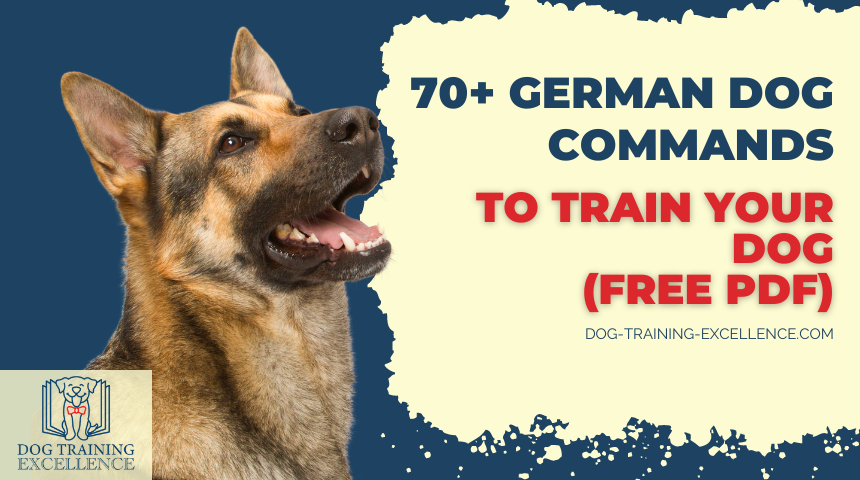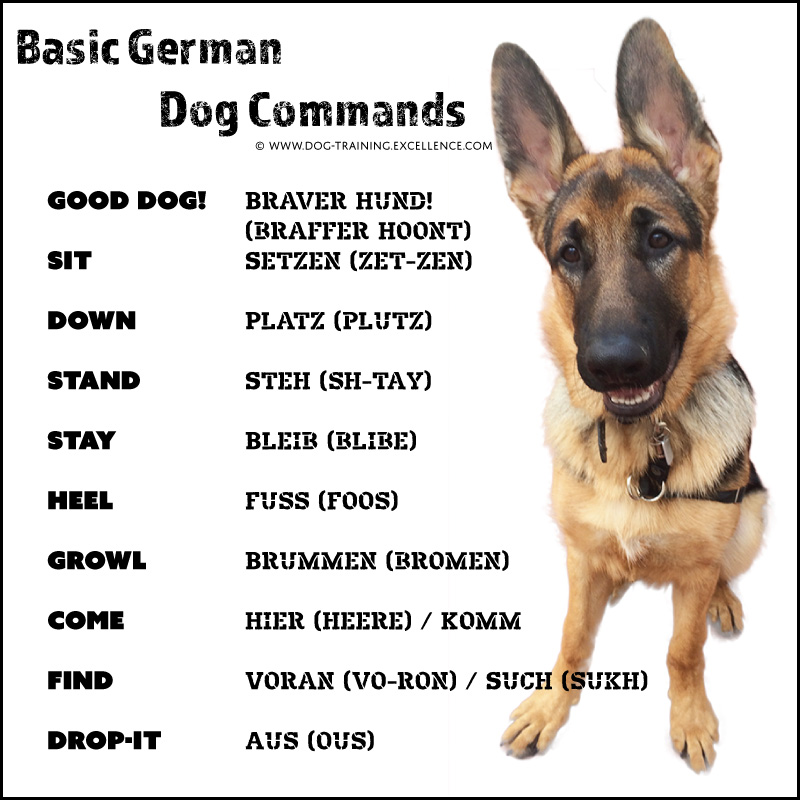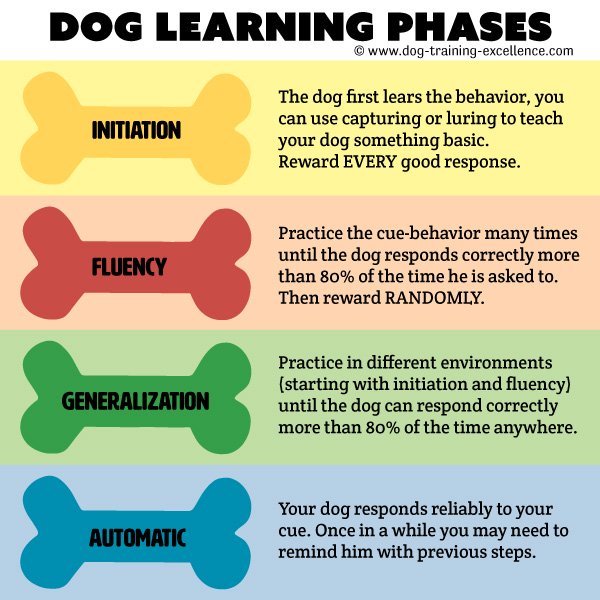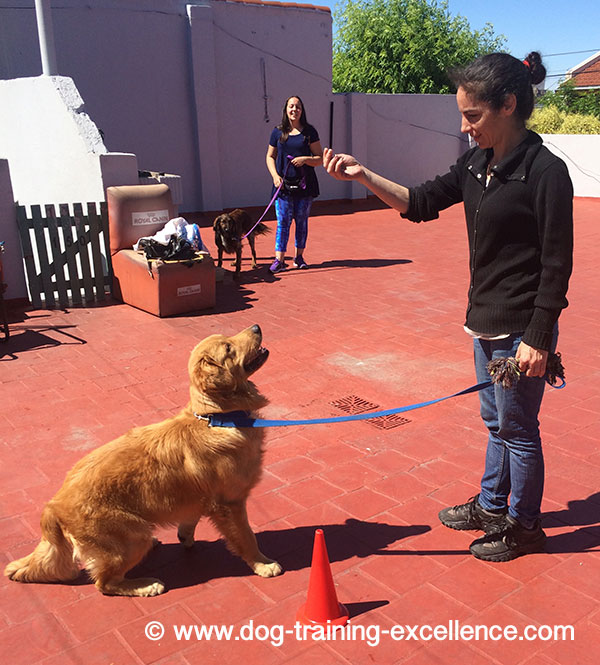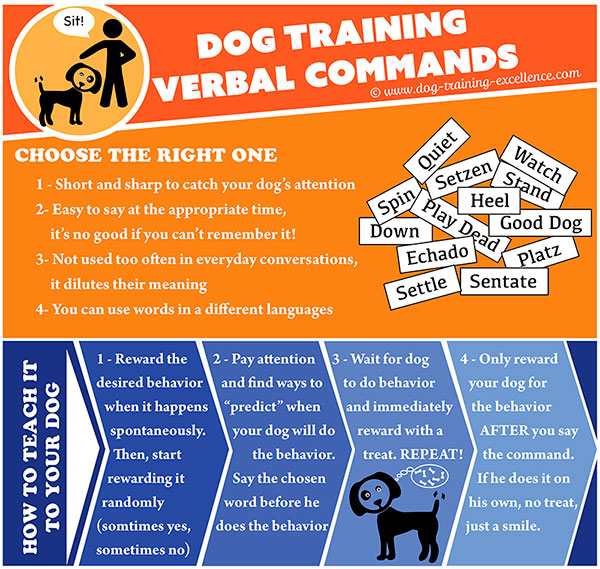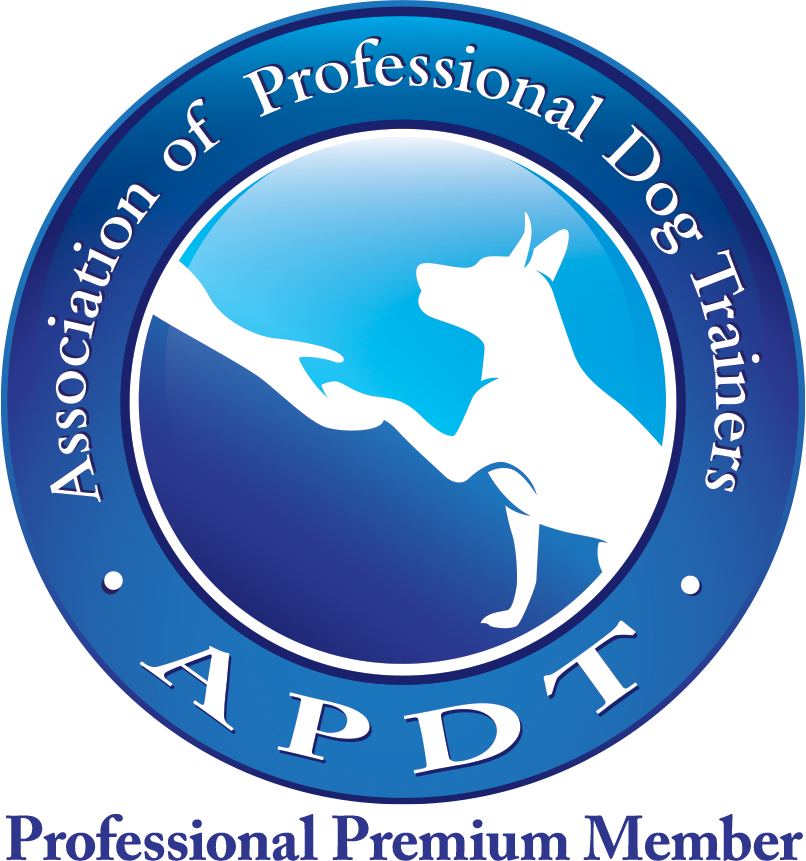I try to write my posts as unbiased as possible and recommend the products I consider to be useful and the best. I use affiliate links, this means that–at no extra cost to you–I can make a commission on a purchase you make after clicking on them. As an Amazon Associate I earn from qualifying purchases.
70+ German Dog Commands
to Train your Dog (Free PDF)
Using German dog commands to train your pet can be both effective and fun. You get to practice a foreign language and your dog may be able to pay more attention to words that are only used to address him.
Article Highlights:
Why use German dog commands to teach your dog obedience?
German is the most popular foreign language to use for dog commands. This may be due to the fact that in the early 1900s, in Germany, there were great efforts to train dogs for police work and also to be used during the war. And many of those projects were very successful, so much that even today we want to keep using that language to communicate with our pet dogs.
It doesn't really matter for the dog, though. You can choose any foreign language, not just German dog commands. What matters is that you are using sounds that are unique and appear only when talking to your canine best friend.
If you want to learn how to teach your canine friend an obedience command find all the information you need here "Dog Training Commands".
Make your commands stand out for your pooch!
Even though we can teach our dogs some words in English, verbal language is not their strength! Using a command in a different language like German, will make it easier for your hound to hear it out from your day to day words.
For example: if you teach your pet the command "sit" but you also use the word often to ask your kids to "sit" at the table! your furry friend will learn that "sit" is not always a reliable word to respond to.
Using German dog commands will make them clear and your puppy will know to respond to them!
Show-off with friends and family!
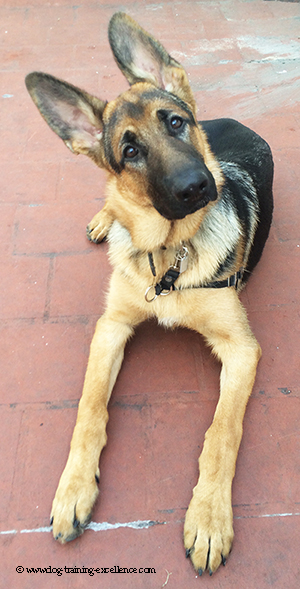
Impress your family and friends with your dog's skills as well as your knowledge of a second language!
Imagine your furry friend trying to jump on your sister in law as she enters, and you confidently saying "Fido setzen". It will blow their mind away!
Have more fun telling them about other German dog training commands they can try on your pet!
It's fun!
Your training sessions will be fun! This is a key element of a good
dog training session. When you are having fun, are relaxed and paying
attention to your furry friend, he/she will learn faster! And both of you will enjoy the time together as well.
List of German dog commands
15 Beginner German Dog Commands
These are the best German dog cues to start training your dog. You can find a link to some of them with instruction on how to get you started. In those instructions replace the "cue" for a German word.
| English | German | Description |
|---|---|---|
| Good dog! | Braver Hund! (braffer Hoont) | This is also known as a marker word, used to mark the correct behavior and signal the dog he/she has earned a treat. |
| Sit | Setzen (zet-zen) or Sitz (Zets) | Request the dog to sit on its hindquarters. |
| Down | Platz (plutz) | Requests the dog to lay down. |
| Stand | Steh (sh-tay) | This command asks the dog to stand from a sitting or a down position. |
| Stay | Bleib (blibe) | Requests the dog to stay in a specific place and position (sit, down or stand) for a specific time. The dog should be released with a marker word or another word. |
| Free or Go | Frei (Frei) or Los (Los) | This is a release word used to tell the dog he is free to stop the previous request, for example he is free to move from a "Stay" cue. Go (Los) can also be used to let the dog know he is free to go outside, walk, etc. |
| Take-it | Nimm (nimbi) | Take or grab an object or item in its mouth. |
| Drop-it | Aus (ous) | Drop or let go of an item in your mouth. |
| Leave-it | Lass es | Do not grab or approach and object or individual. |
| Kennel | Zwinger (Zuingr) | Go to your kennel |
| Go to Bed | Geh ins bett | Go to your mat or bed and relax. |
| Settle | Beruhigen (Berhu-igen) | Calm down, go from an active state to a quieter relaxed state. |
| Come | Hier (heere) / Komm | German dog command for recall, asks your dog to come to you when called. |
| Target | Zielen auf (Zeelen Auf) | Touch my hand/fist with your nose. Alternative, touch a target stick with your nose. |
| Gentle | Vorsichtig (Vor-sich-tig) | Take a treat or object with your mouth gently, without biting. |
Are you a dog lover?
Of course! If you are here...you are a dog lover...like me! and if you are a dog lover, you may also love these super funny home accessories!
Sorry the dog farted!
If you have a specially stinky or smelly dog, this candle must be in your living room to make your guests laugh! |
People tolerated 🤣
If you LOVE dogs, chances are...you only tolerate people... is this true? Then this special decoration is for you! |
18 Advanced Dog Commands in German
If your dog already knows basic German cues, it's time to increase the difficulty with these advanced German dog command. Teaching your dog many cues and commands increases its well being because training stimulates its brain!
| English | German | Description |
|---|---|---|
| Heel | Fuss (Foos) | Walk next to me at the same speed. Dog should not be lagging behind or walking ahead of the person. |
| Go potty | Mach Pipi (Mag pi-pi)/ Mach Geschäft (max ge-schäft) | Pee on command. |
| Left | Links (lins) | Turn to your left. |
| Right | Rechts (Reg-ts) | Turn to your right |
| Back-up | Zurückweichen (Zuruk-vaishen) | Walk backwards. |
| Fast | Schneller (Schnel-ler) | Walk at a faster pace. |
| Slow | Langsam (Lang-sam) | Walk at a lower pace. |
| Watch | Achtung (Ahktoong) | Look at me, it could be in a stationary position or while walking on heel position. |
| Wait | Warten (varten) | Pause what your are doing momentarily. Tells your dog to wait for you to reach him or her. |
| Still | Ruhig (Rui) | Stay still in the position you are. This command indicates the dog to freeze in place. |
| Fetch | Apport (ah-port) / Bring (brink) | Bring an item to me and place it in my hands or indicate place. |
| Put away | aufräumen (auf-räu-men) | Put your toys away in a designated box or place. |
| Stop That! | Pfui (Foo-ey) | Similar to Leave-it, the difference is that the dog is already engaging in an unwanted behavior and we ask him/her to stop. |
| Speak | Gib laut (gib-lout) | To bark on command. |
| Quiet | Ruhig (ru-hig) | To stop barking on command. |
| Go to Sleep | Geh Schlafen (Ge Shlaafn) | Go to your mat or bed and lay down to relax or sleep. |
| Touch | Berühren (Begrurhen) | Touch the object or person that I am pointing at. |
| Chin rest | Kinn | Lower your chin to the floor or surface. |
Recommended Positive Dog Training Tools
Positive dog trainers are known to use very little gadgets and tools. This is because we want training to be positive and won't use corrective leashes nor other corrective tools. We do use 3 very basic tools for dog training, here are my favorite ones:
The perfect treat
The perfect treat is small, yummy, healthy and easy to store just like Stewart Freeze Dried Dog Treats. Freeze dried treats are natural and easy to carry around without making a mess and dogs love them!
The pouch
Professionals use treat pouches because they free your hands and help with timing. The best one have a magnetic clasp and a removable inner bag for easy washing like the Viklluyr Dog Treat Pouch.
The clicker
This one is NOT an absolute must, but when you get to advanced training it will be a good tool to have. My favorite kind is a clicker ring, because it also keeps your hands free. Clicker training is fun!
15 Working Dog Commands in German
Some advanced dog training cues are specific for working dogs. Dogs perform many different jobs along with humans including search and rescue, tracking, finding drugs and other illegal items, police and military work, guarding and defense, etc. Here are some common dog training commands in German that have to do mostly with search and rescue and guard and defense.
| English | German | Description |
|---|---|---|
| Search/Find | Voran (vo-ron) / Such (sook) | Find a lost item or person or search an area for a specific odor. |
| Track | Fährte (Fähr-te) / Spur (Shpur) | Follow a scent trail. |
| Stop | Anhalten | When the dog is in active movement, we ask them to stop in their tracks. |
| Crawl | Kriechen (Kirchen) | Move forward with your belly touching the ground. |
| Attack | Fass (faas) | Jump and grab the arm of the person threatening me. |
| Guard | Wach (Vax) / Pass auf ( | Guard and protect and area, a person or a group of animals or people. |
| Howl | Heulen (Hoilen) | Howl on command. |
| Growl | Brummen (bromen) | Growl on command |
| Jump | Hopp (Hup) | Jump over an obstacle |
| On top | Obendrauf (o-ben-drauf) | Jump on top of an elevated surface. |
| Go around | Herumgehen (her-um-ge-hen) | Go around an object or obstacle. |
| Onwards | Vorwärts (for-wärts) | This is a signal to keep going forward. |
| Outside | Raus (Raus) | This is a signal to tell the dog to go outside. |
| Inside | Komm Rein (Kom-rein) | This is a signal to tell the dog to go outside. |
| Hold it | Halte es (Hal-tees) | Your dog should grab and hold in its mouth an item or object. |
24 dog tricks in German
| English | German | Description |
|---|---|---|
| Shake hands (Paw) | Pfote (fote) | Ask your dog to place its paw on your hand while you shake it. |
| Roll Over | Umdrehen (Umdre-en) | Command to ask your dog to roll-over on the floor. |
| Belly/ Dead (Play dead) | Bauch (Bauj) / Tot (To-ot) | Cue to ask your dog to lay down and show his/her belly, aka "play dead" |
| High-five | Gib fünf (Gib-funf) | Ask your dog to give you a high-five |
| Wave "goodbye" or "hello" | Tschüss (t-chis) | Wave with your paw. |
| Sit pretty or beg | Sitze hübsch (Set-ze Hubsh) / Bitten | To raise both paws up front while the rear remains on the floor. |
| Bow | Sich verbeugen (sij verbogen) | Take a bow, the dog lowers its fron shoulders while living it's rump up. A play-bow. |
| Spin | Dreh dich (Dre dij) | Spin around in a complete circle clockwise. |
| Twirl | Drehen (Dre-en) | Spin around in a complete circle counter-clockwise. |
| Go hide | Versteck dich (Vershtek Dig) | Ask your dog to hide behind a wall or big piece of furniture. |
| Jump into my arms | Flieg (Flig) | Usually for small dogs, ask them to jump into your arms. |
| Weave | Slalom | Weave through my legs or slalom through a set of pols lined up in a row. |
| Kiss | Küsschen (Kusien) | Ask your dog to kiss you or lick you on your cheek. |
| Shake your body | Abschütteln (Abshtten) | Dog shakes as if it was trying to shake off water. |
| Say your prayers | Gebet (Ge-bet) | Dog puts both front paws on an elvated surface (like a bed) and lowers it's chin down as if in prayer. |
| Handstand or Spiderman | Handstand (Handsh-stant) | Dog climbs a wall with its bag legs. |
| Peek-a-boo or bridge | Guck-Guck (Guk-Guk) | Dog moves around the person and comes half way through its open legs looking up. |
| Tuck yourself in bed | Bedecke dich (Bedeke-dish) | Dog lays down on a blanker, grabs a corner of the blanket and rolls-around covering himself with it. |
| Yawn | Gähnen (Geinen) | Cue that tells your dog to yawn. |
| Limp | Humpeln (Hump-eln) | Dog walks with a limp front paw. |
| Find your leash | Such die Leine (Sug di laine) | Ask your dog to find the leash and bring it to you. |
| where is your ball? | Wo ist dein Ball? (Vo es dein val) | Ask your dog to find a ball and bring it to you. |
| Stand in two legs | Aufrecht stehen (Auf-rect Ste-en) | Cue for your dog to stand on its back legs only. |
| Moonwalk | Mondspaziergang (Mond-shpazier-gang) | Cue for your dog to walk backwards in a bow position. |
Free List of German dog Commands PDF
Sign up to "The Yes Dog" our Monthly e-newsletter and receive a FREE printable PDF list of 70+ German dog commands.
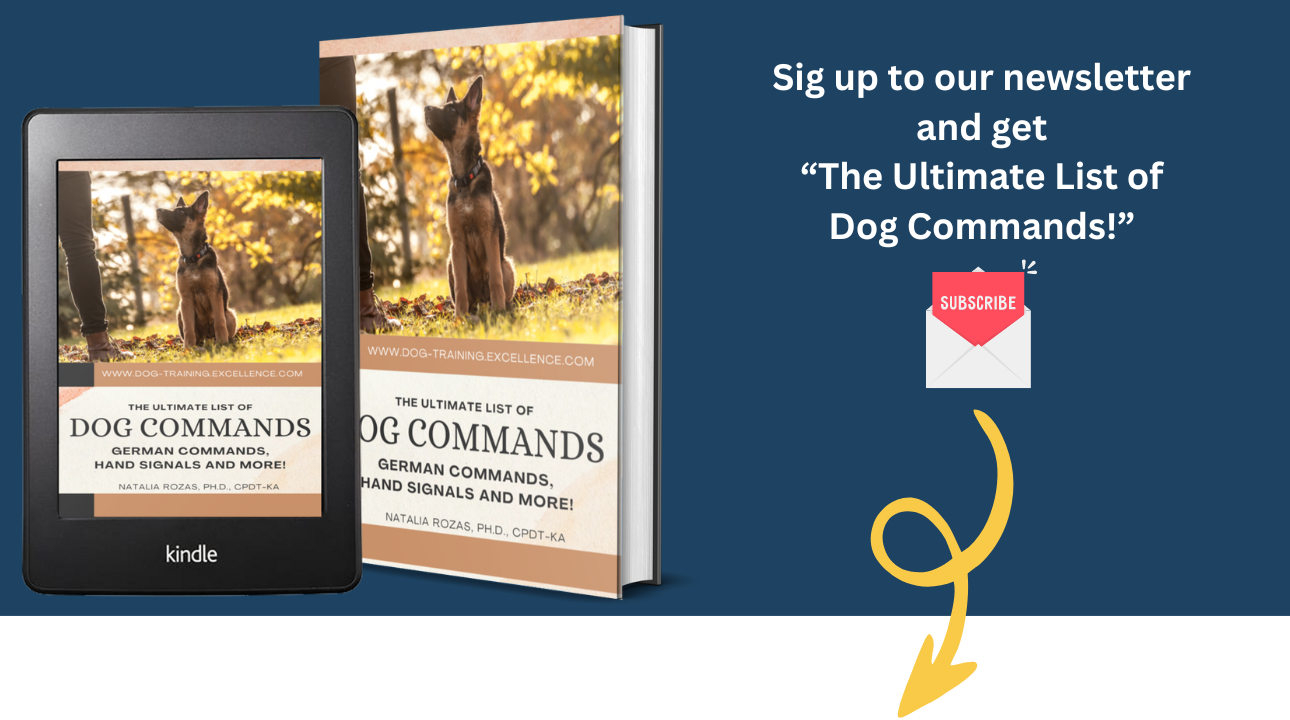
Sign up to The Yes Dog!

Our newsletter name ("The YES dog") was created to promote positive dog training methods (say -yes- instead of punishment) and the acronym also tells you what you will get into your inbox:
Yeehaw with your dog (find joy with fun activities)
Explore dog science (learn about your best friend)
Sayings that inspire (a quote to help you bond with your dog)
Frequently asked questions about german dog commands
What is the German Dog Commands pronunciation?
What is the German Dog Commands pronunciation?
If you are having some difficulty with pronunciation, you can try the "pronunciation dictionary". All you have to do is copy the word you are trying to learn and then paste in the dictionary. Then you can hear how it sounds!
Do dogs respond better to German?
Do dogs respond better to German?
Not really, dogs respond better to proficiently applied positive training techniques. You can use any type of cue, verbal cues (in any language) or visual cues (hand signals). Many times, using verbal cues in a different language can help your dog distinguish better your everyday talk from dog commands.
What is the easiest language to train dogs?
What is the easiest language to train dogs?
If you are wondering what language do dogs understand most, the answer is proficiently applied positive training techniques. The type of cue (verbal, visual, tactile, language, etc.) is not relevant. If you know how to train a dog, your dog will learn anything!
Why are German dogs so smart?
Why are German dogs so smart?
Actually, all dogs are smart. What makes an obedient and reliable dog is the type of training and the clarity and consistency of the trainer. If you think your dog is not smart, let a professional dog trainer show you that your dog is really smart!
Do police dogs understand German?
Do police dogs understand German?
No, unless the dog has been specifically trained to understand german dog commands. However, if a dog has been trained to understand some german cues, that does not mean the dog actually understand the language.
Was this article helpful?
2 ways to help me continue writing professional training content
|
I am a Certified Professional Dog Trainer with more than 15 years of experience. You can hire my services through my Online Dog Training Academy.
|
For as little as $1 a month you can be my Patron and get exclusive benefits while helping me to continue to create the best and most updated content about dog training and positive methods. Be a modern philanthropist through Patreon.com |
This article was written by Natalia Rozas, Ph.D. and Certified Professional Dog Trainer (CPDT-KA #4071465) and updated on March 28th, 2024. Case studies and anecdotes are real but to protect the privacy of our clients the names and details are changed.
- Home
- Dog Commands
- German Dog Commands
